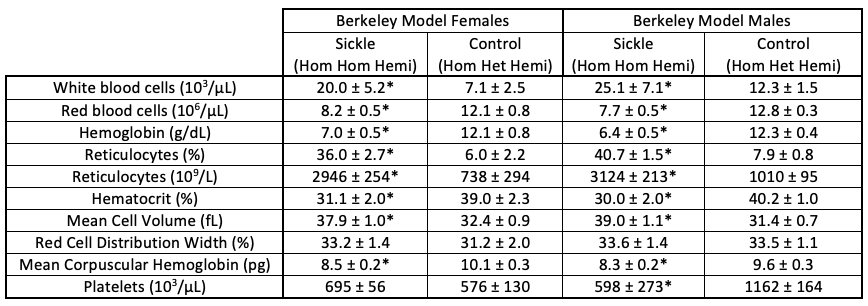Sickle Cell Disease Phenotypes in Townes & Berkeley Mouse Models
Townes model mice (B6;129-Hbbtm2(HBG1,HBB*)Tow/Hbbtm3(HBG1,HBB)Tow Hbatm1(HBA)Tow/J, 013071) develop sickle cell disease in the presence of human knock-in alleles that replace mouse α-globin and β-globin. The Berkeley model (STOCK Hbatm1Paz Hbbtm1Tow Tg(HBA-HBBs)41Paz/J, 003342) also develops sickle cell disease due to a human hemoglobin transgene and deficiency in mouse α-globin and β-globin. Aspects of sickle cell disease include:
- Elevated white blood cell & reticulocyte counts and increased mean red blood cell volume in males and females of both strains (Table 1, 2)
- Reduced red blood cells, hemoglobin, and hematocrit in males and females of both strains (Table 1, 2)
- Decreased mean corpuscular hemoglobin (males & females) and platelets (males) in the Berkeley model (Table 2)
Body weights and complete hematology data are available in the Mouse Phenome Database.
Table 1: Townes Model Hematology. Submental blood was collected into EDTA-coated microtainers and analyzed using a Siemens Advia 2120 hematology analyzer. Data represent mean and one standard deviation of 10 mice per sex and genotype, aged 8 weeks. Each parameter was analyzed separately by sex using a one-way ANOVA; an * indicates that the sickle genotype was significantly different (P < 0.0001) from both control genotypes. Each column header indicates the human beta-globin genotype and the JAX genotype ordering code.

Table 2: Berkeley Model Hematology. Blood was collected as described in Table 1 from 8-12 mice per sex and genotype. Each parameter was analyzed separately by sex using an unpaired two-tailed t-test; an * indicates that the sickle genotype was significantly different (P < 0.0001) from the control genotype.
